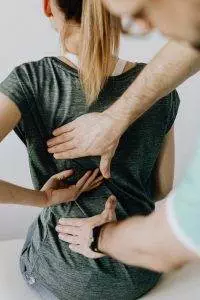By Xiaomei Cai, L.Ac., Ph.D. and Qineng Tan, L.Ac., Ph.D.

Muscle aches and pains? Knotted muscles? Pain in trigger points? These could be signs of myofascial pain syndrome. Acupuncture and TCM can provide myofascial release and help relieve chronic myofascial pain (MPS pain).
Myofascial pain disorder is a common, yet often overlooked chronic pain condition that affects the muscles and fascia. Fascia is the thin connective tissue that is found all over the body, holding muscles, organs, and blood vessels together. Fascia is also filled with nerves, which makes it highly sensitive.
Healthy fascia is thin, stretchy and pliable. Stress, injuries, weakness and other issues can cause fascia to tighten up, become sticky, dry, or thicker. This can cause painful knots to develop in your muscles.
These areas are sometimes called fascial adhesions, or myofascial trigger points, and they can be very tender to the touch and cause muscle soreness, aches and pains.
Chronic myofascial pain can seem very similar to fibromyalgia, or symptoms of ME/CFS, and is sometimes misdiagnosed as such. However, these conditions are distinct from one another.
Fibromyalgia causes widespread, diffuse pain and tenderness all over the body, while myofascial pain is centered around specific trigger point sites. Fibro, as it is sometimes called, is believed to be caused by a disorder within the central nervous system. Fibromyalgia is usually triggered by stress, trauma, hormonal changes, lack of sleep, or sensitivities to weather changes.
It has been suggested that long-term myofascial pain syndrome may ultimately lead to a person developing fibromyalgia, as the brain and nervous system become so used to experiencing pain that they begin to produce disordered pain signaling.
Acupuncture treatment, cupping, and therapeutic Chinese massage can provide trigger point therapy that is effective for relieving tight muscles and soreness.
Myofascial Pain Syndrome Symptoms

People experience myofascial pain differently from one another; each case is unique. For some people, the pain can come and go suddenly; for others, it’s a constant, dull pain.
Myofascial pain syndrome can feel like:
- Tight muscles, stiffness
- Throbbing pain
- Dull, aching pain
- Sore muscles, tender areas
- Knotted muscles, nodules or bumps in specific areas that are sore
- Muscle weakness
- Limited range of motion
- Trouble sleeping
- Headaches
- Fatigue
Myofascial pain can be localized in one area, or referred pain, which spreads to other nearby areas. Myofascial referred pain patterns can look like pain that originates in the rotator cuff which then spreads to the deltoid, and even down the arm to the hand.
What Causes Myofascial Pain?
Medical science is not entirely clear on the causes of myofascial pain syndrome, but it seems to occur more often in people who have experienced things like:
- Periods of inactivity, such as having one of your limbs in a cast
- Repetitive movements in your work
- Pinched nerves
- Injury to a muscle or muscle group
- Having to work outdoors in the cold
- Diabetic neuropathy
- Thyroid disorders, hypothyroidism
- Deficiencies in Vitamin D or folate, or iron deficiency
- Stress, chronic tension that leads to clenched muscles
- Structural conditions like scoliosis, spondylosis, or osteoarthritis
Estimates suggest that the majority of people who are treated for chronic musculoskeletal pain may have myofascial pain syndrome. Up to 85% of the general population may experience myofascial pain at some point in time.
Treatment for Myofascial Pain Syndrome
One of the primary approaches to managing myofascial pain syndrome is physical therapy. Physical therapists may use manual therapy, stretching exercises, and postural correction to address muscle imbalances, improve flexibility, and release tension in affected muscles. Trigger point therapy, which involves applying pressure to trigger points to release muscle knots and promote relaxation, is a common component of physical therapy for MPS.
Modalities such as heat therapy and cold therapy may also be used in conjunction with physical therapy to provide pain relief and enhance the effectiveness of treatment. Heat therapy helps to increase blood flow and promote muscle relaxation, while cold therapy can reduce inflammation and numb the affected area.
In addition to physical therapy and modalities, medications may be prescribed to manage pain and improve symptoms associated with myofascial pain syndrome. Nonsteroidal anti-inflammatory drugs (NSAIDs) such as ibuprofen or naproxen may be recommended to reduce inflammation and alleviate pain. Muscle relaxants such as cyclobenzaprine or benzodiazepines may also be prescribed to help relax tense muscles and improve sleep quality. In some cases, tricyclic antidepressants or anticonvulsant medications may be used to modulate pain signals and improve overall pain management.
Trigger point injections are another treatment option for myofascial pain syndrome, particularly for individuals who experience severe or persistent symptoms that do not respond adequately to conservative measures. During a trigger point injection procedure, a local anesthetic or corticosteroid is injected directly into the trigger point to help alleviate pain and reduce muscle tension.
Acupuncture needling is also considered an effective and valuable treatment option for myofascial release and relief of musculoskeletal pain.
Can Acupuncture Help Myofascial Pain Syndrome?

Many studies conducted over the past two decades point to acupuncture as an effective mode of treatment for myofascial pain syndrome.
Acupuncture is effective for myofascial pain because it can positively affect the central nervous system, increase blood flow, increase endorphin production, improve fascial adhesions, and promote muscle relaxation. Acupoints used in TCM correspond closely with myofascial trigger points.
One study looked at patients who received two acupuncture treatments per week for four weeks on trigger points in the upper trapezius. Patients reported significant reduction in pain after just two weeks.
Another study followed two groups of patients with myofascial pain centered in the neck area. One group received acupuncture treatment. The other group had acupuncture and also engaged in regular aerobic exercise. Findings showed that both groups experienced significant improvement in pain symptoms.
A review of studies found that acupuncture was effective both for reducing myofascial pain and improving function and mobility.
Acupuncturists may also use electro-acupuncture, cupping, and massage techniques like gua sha and tui na to help move lymph and blood, release muscle trigger points, and improve muscular movement that has been limited by pain.
Acupuncture Near Me for Myofascial Pain Syndrome in Los Angeles
At Art of Wellness Acupuncture in West L.A., we have over 35 years of experience helping people find relief from musculoskeletal pain of all kinds. Dr. Tan and Dr. Cai are able to use electro-acupuncture, cupping, and massage techniques like Tuina for myofascial release. If you are suffering from muscle pain and tenderness, do not hesitate to make an appointment with us.
*This article is for education from the perspective of Traditional Chinese Medicine only. The education provided by this article is not approved by FDA to diagnose, prevent, treat and cure human diseases. It should not stop you from consulting with your physician for your medical conditions. Traditional Chinese Medicine is based on Qi, which is an invisible force that usually cannot be observed by modern science. Because science focuses on testing ideas about the natural world with evidence obtained through observation, these aspects of acupuncture can’t be studied by science. Therefore acupuncture and Chinese herbs are often not supported by double-blind, randomized trials, and they are considered alternative medicine therapies in the United States.
